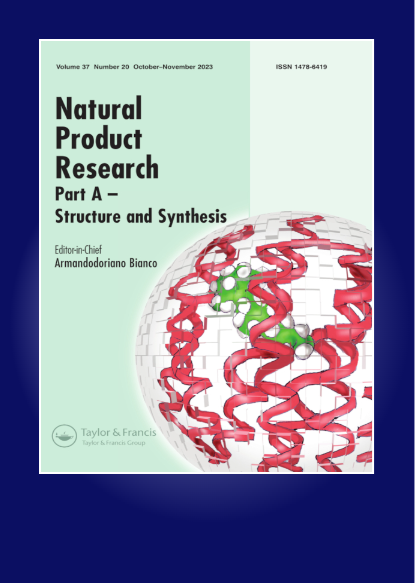Chemical composition and antioxidant activity of the Amazonian fruit Ambelania acida Aubl
IF 1.6
3区 化学
Q3 CHEMISTRY, APPLIED
引用次数: 0
Abstract
Aqueous and hydroalcoholic extracts from the pulp of Ambelania acida Aubl. (Apocynaceae) fruits were subjected to analysis through UHPLC-HRMS and antioxidant potential using the TPC, DPPH, ABTS, FRAP, and ORAC assays. A putative identification of the compounds carried out by comparison of the fragmentation spectra revealed the predominance of the monoterpene indole alkaloids tabersonine, pseudocopsinine, ajmalicine, and strictosidine. Additionally, gallic acid, caffeic acid, citric acid, 3-O-p-coumaroylquinic acid, chlorogenic acid, catechin, ellagic acid, eschweilenol C (ellagic acid deoxyhexoside), and sucrose were identified. In face of the phenolic compounds observed, hydroalcoholic extract showed a higher antioxidant activity compared to the aqueous extract, observed at TPC (108.85 mg GAE/100g), FRAP (0.73 µmol Fe2SO4/g), DPPH (1221.76 µmol TE/g), ABTS (3460.00 µmol TE/g), and ORAC assays (120.47 µmol TE/g). These findings underscore the abundant presence of bioactive compounds, including phenolics and alkaloids, in an edible Amazonian fruit.
亚马逊水果Ambelania acida Aubl.的化学成分和抗氧化活性
通过超高效液相色谱-高分辨质谱法(UHPLC-HRMS)对安贝拉(Apocynaceae)果实果肉中的水提取物和水醇提取物进行分析,并使用TPC、DPPH、ABTS、FRAP和ORAC测定法对抗氧化潜力进行分析。通过比较碎片光谱,对化合物进行了推定鉴定,结果表明单萜吲哚生物碱 tabersonine、pseudocopsinine、ajmalicine 和 strictosidine 占主导地位。此外,还发现了没食子酸、咖啡酸、柠檬酸、3-O-p-香豆酰奎宁酸、绿原酸、儿茶素、鞣花酸、埃施魏仑醇 C(鞣花酸脱氧己苷)和蔗糖。在所观察到的酚类化合物中,水醇提取物的抗氧化活性高于水提取物,在 TPC(108.85 毫克 GAE/100克)、FRAP(0.73 微摩尔 Fe2SO4/克)、DPPH(1221.76 微摩尔 TE/克)、ABTS(3460.00 微摩尔 TE/克)和 ORAC(120.47 微摩尔 TE/克)检测中均可观察到。这些研究结果表明,亚马逊河流域的一种可食用水果中含有丰富的生物活性化合物,包括酚类和生物碱。
本文章由计算机程序翻译,如有差异,请以英文原文为准。
求助全文
约1分钟内获得全文
求助全文
来源期刊

Natural Product Research
化学-医药化学
CiteScore
5.10
自引率
9.10%
发文量
605
审稿时长
2.1 months
期刊介绍:
The aim of Natural Product Research is to publish important contributions in the field of natural product chemistry. The journal covers all aspects of research in the chemistry and biochemistry of naturally occurring compounds.
The communications include coverage of work on natural substances of land and sea and of plants, microbes and animals. Discussions of structure elucidation, synthesis and experimental biosynthesis of natural products as well as developments of methods in these areas are welcomed in the journal. Finally, research papers in fields on the chemistry-biology boundary, eg. fermentation chemistry, plant tissue culture investigations etc., are accepted into the journal.
Natural Product Research issues will be subtitled either ""Part A - Synthesis and Structure"" or ""Part B - Bioactive Natural Products"". for details on this , see the forthcoming articles section.
All manuscript submissions are subject to initial appraisal by the Editor, and, if found suitable for further consideration, to peer review by independent, anonymous expert referees. All peer review is single blind and submission is online via ScholarOne Manuscripts.
 求助内容:
求助内容: 应助结果提醒方式:
应助结果提醒方式:


